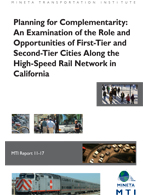- 408-924-7560
- mineta-institute@sjsu.edu
- Donate
Planning for Complementarity: An Examination of the Role and Opportunities of First-Tier and Second-Tier Cities Along the High-Speed Rail Network in California
The coming of California High-Speed Rail (HSR) offers opportunities for positive urban transformations in both first-tier and second-tier cities. The research in this report explores the different but complementary roles that first-tier and second-tier cities along the HSR network can play in making California more sustainable and less dependent on fossil fuels while reducing mobile sources of greenhouse gas emissions and congestion at airports and on the state’s roadways. Drawing from case studies of cities in Northern and Southern California, the study develops recommendations for the planning, design, and programming of areas around California stations for the formation of transit-supportive density nodes.
ANASTASIA LOUKAITOU-SIDERIS, PhD
Anastasia Loukaitou-Sideris is Associate Dean of the UCLA School of Public Affairs and Professor at the UCLA Department of Urban Planning. Her area of specialization is urban design, physical and land use planning. She has published extensively on issues of downtown redevelopment, inner-city revitalization, transit-oriented development, design and transit safety, and parks and open spaces. She has served as a consultant to the Transportation Research Board, Federal Highway Administration, Southern California Association of Governments, South Bay Cities Council of Government, Los Angeles Neighborhood Initiative, Mineta Transportation Institute, Robert Wood Johnson Foundation, the Greek government, and many municipal governments on issues of urban design, open space development, land use and transportation. Her research has been supported by the U.S. and California Departments of Transportation, the Haynes Foundation, the National Endowment for the Arts, the Mineta Transportation Institute, the California Policy Research Seminar, the Poverty and Race Research Action Council, the UCLA International Institute, and the UCLA Institute of American Cultures. Her books include Urban Design Downtown: Poetics and Politics of Form (1998), Jobs and Economic Development in Minority Communities (2006), Sidewalks: Conflicts and Negotiation over Public Space (2009), and Companion to Urban Design (2011).
DANA CUFF, PhD
Dana Cuff is a professor, author and practitioner in architecture. Her work focuses on affordable housing, modernism, suburban studies, the politics of place, and the spatial implications of new computer technologies. Cuff’s research on postwar urbanism was published in a book titled The Provisional City (MIT 2000), and she recently edited Fast Forward Urbanism with Roger Sherman (Princeton Architectural Press 2011). She founded cityLAB in 2006 and has since concentrated her efforts around issues of the emerging metropolis. Dr. Cuff is widely published, the recipient of numerous fellowships, and she lectures internationally.
HARRISON HIGGINS
Harrison Higgins joins cityLAB as its Associate Director and Researcher in Architecture and Urban Design. He is an architect by training, via Princeton and SCIArc, and an urban designer and community planner by practice. Prior to joining cityLAB he was associate director of the Florida Planning and Development Lab. Higgins' own research interests – concerning the cultural aspects of neighborhood change; planning and design for environmental hazards, urban mobility and transportation; and new forms of spatial data representation – have been funded by various Federal and state agencies and foundations. Each of his research areas is particularly important to Los Angeles, to architecture's relevance in an urban context, and to cityLAB.
WENBIN WEI, PhD
Wenbin Wei is an associate professor in the Department of Aviation and Technology and an affiliated professor in the Department of Industrial and System Engineering, at San Jose State University. He is the director of the Human Automation Integration Lab (HAIL) and a research associate at the Mineta Transportation Institute. He holds a PhD from University of California, Berkeley, majoring in transportation engineering and management, with minors in economics, and in industrial engineering and operations research. He has a master of science degree from Carnegie Mellon University with a concentration in computer-aided engineering and management. Before joining the faculty at San Jose State University, Dr. Wei worked as a postdoctoral researcher at both the California PATH program and the NEXTOR aviation research center from 2000 to 2001. He was a research analyst in the Department of Operation Research and Decision Support at American Airlines from 2001 to 2003. Dr. Wei's main research and teaching interests include transportation planning, urban transportation, public transportation, air traffic control and management; airline operations and management; airport planning and management; logistics; and supply chain management.
-
Contact Us
San José State University One Washington Square, San Jose, CA 95192 Phone: 408-924-7560 Email: mineta-institute@sjsu.edu






